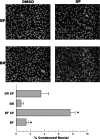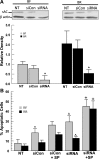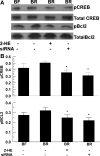Soluble adenylyl cyclase mediates bicarbonate-dependent corneal endothelial cell protection
- PMID: 21123735
- PMCID: PMC3043628
- DOI: 10.1152/ajpcell.00314.2010
Soluble adenylyl cyclase mediates bicarbonate-dependent corneal endothelial cell protection
Abstract
Cyclic AMP produced from membrane receptor complex bound adenylyl cyclases is protective in corneal endothelial cells (CEC). CEC also express soluble adenylyl cyclase (sAC), which is localized throughout the cytoplasm. When activated by HCO(3)(-), cAMP concentration ([cAMP]) increases by ∼50%. Here we ask if cAMP produced from sAC is also protective. We examined the effects of HCO(3)(-), pH, phosphodiesterase 4 inhibition by rolipram, sAC inhibition by 2HE (2-hydroxyestradiol), and sAC small interfering RNA (siRNA) knockdown on basal and staurosporine-mediated apoptosis. HCO(3)(-) (40 mM) or 50 μM rolipram raised [cAMP] to similar levels and protected endothelial cells by 50% relative to a HCO(3)(-)-free control, whereas 2HE, which decreased [cAMP] by 40%, and H89 (PKA inhibitor) doubled the apoptotic rate. sAC expression was reduced by two-thirds in the absence of HCO(3)(-) and was reduced to 15% of control by sAC siRNA. Protection by HCO(3)(-) was eliminated in siRNA-treated cells. Similarly, caspase-3 activity and cytochrome c release were reduced by HCO(3)(-) and enhanced by 2HE or siRNA. Analysis of percent annexin V+ cells as a function of [cAMP] revealed an inverse, nonlinear relation, suggesting a protective threshold [cAMP] of 10 pmol/mg protein. Relative levels of phosphorylated cAMP response element binding protein and phosphorylated Bcl-2 were decreased in CEC treated with 2HE or siRNA, suggesting that HCO(3)(-)-dependent endogenous sAC activity can mobilize antiapoptotic signal transduction. Overall, our data suggest a new role for sAC in endogenous cellular protection.
Figures







Similar articles
-
HCO(3)(-)-dependent soluble adenylyl cyclase activates cystic fibrosis transmembrane conductance regulator in corneal endothelium.Am J Physiol Cell Physiol. 2003 May;284(5):C1114-22. doi: 10.1152/ajpcell.00400.2002. Epub 2003 Jan 8. Am J Physiol Cell Physiol. 2003. PMID: 12519749 Free PMC article.
-
Inhibition of osteoclast formation and function by bicarbonate: role of soluble adenylyl cyclase.J Cell Physiol. 2009 Aug;220(2):332-40. doi: 10.1002/jcp.21767. J Cell Physiol. 2009. PMID: 19360717 Free PMC article.
-
Decreased soluble adenylyl cyclase activity in cystic fibrosis is related to defective apical bicarbonate exchange and affects ciliary beat frequency regulation.J Biol Chem. 2010 Sep 24;285(39):29998-30007. doi: 10.1074/jbc.M110.113621. Epub 2010 Jul 16. J Biol Chem. 2010. PMID: 20639512 Free PMC article.
-
Intracellular cAMP signaling by soluble adenylyl cyclase.Kidney Int. 2011 Jun;79(12):1277-88. doi: 10.1038/ki.2011.95. Epub 2011 Apr 13. Kidney Int. 2011. PMID: 21490586 Free PMC article. Review.
-
CO(2)/HCO(3)(-)-responsive soluble adenylyl cyclase as a putative metabolic sensor.Trends Endocrinol Metab. 2001 Oct;12(8):366-70. doi: 10.1016/s1043-2760(01)00454-4. Trends Endocrinol Metab. 2001. PMID: 11551811 Review.
Cited by
-
Role of soluble adenylyl cyclase in the heart.Am J Physiol Heart Circ Physiol. 2012 Feb 1;302(3):H538-43. doi: 10.1152/ajpheart.00701.2011. Epub 2011 Nov 4. Am J Physiol Heart Circ Physiol. 2012. PMID: 22058150 Free PMC article. Review.
-
Cyclic AMP is both a pro-apoptotic and anti-apoptotic second messenger.Acta Physiol (Oxf). 2012 Feb;204(2):277-87. doi: 10.1111/j.1748-1716.2011.02273.x. Epub 2011 May 26. Acta Physiol (Oxf). 2012. PMID: 21385327 Free PMC article. Review.
-
Soluble adenylyl cyclase in the eye.Biochim Biophys Acta. 2014 Dec;1842(12 Pt B):2579-83. doi: 10.1016/j.bbadis.2014.07.032. Epub 2014 Aug 6. Biochim Biophys Acta. 2014. PMID: 25108282 Free PMC article. Review.
-
Adenylyl cyclases in the digestive system.Cell Signal. 2014 Jun;26(6):1173-81. doi: 10.1016/j.cellsig.2014.01.033. Epub 2014 Feb 9. Cell Signal. 2014. PMID: 24521753 Free PMC article. Review.
-
pH sensing via bicarbonate-regulated "soluble" adenylyl cyclase (sAC).Front Physiol. 2013 Nov 25;4:343. doi: 10.3389/fphys.2013.00343. Front Physiol. 2013. PMID: 24324443 Free PMC article. Review.
References
-
- Barcia RN, Dana MR, Kazlauskas A. Corneal graft rejection is accompanied by apoptosis of the endothelium and is prevented by gene therapy with bcl-xL. Am J Transplant 7: 2082–2089, 2007 - PubMed
-
- Bertrand R, Solary E, O'Connor P, Kohn KW, Pommier Y. Induction of a common pathway of apoptosis by staurosporine. Exp Cell Res 211: 314–321, 1994 - PubMed
-
- Bonanno JA, Giasson C. Intracellular pH regulation in fresh and cultured bovine corneal endothelium. II. Na+:HCO3− cotransport and Cl-/HCO3− exchange. Invest Ophthalmol Vis Sci 33: 3068–3079, 1992 - PubMed
Publication types
MeSH terms
Substances
Grants and funding
LinkOut - more resources
Full Text Sources
Research Materials

